
-
Salvilla. Silver. Edward, John & William Barnard. England, London, 1862. With contrast marks. Round salver with mixed linear contours decorated with elements in light relief towards the edge and engravings towards the centre, arranged around initials, and raised on legs with vegetal and architectural elements combining a polished finish with another. Edward Barnad & Sons was a company that was founded in London around 1860 by Anthony Nelme. Edward Barnad (died 1855) became the owner in 1829, trading as Edward Barnad & Sons, together with his sons Edward (died 1868), John and William (died 1851). Weight: 750 gr.
· Size: 30x30x3,5 cms.
ANTIQUES
MISCELLANEUS;SILVER
Ref.: ZF0721
-
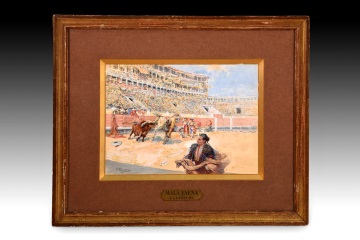
Bad job. Watercolor. Signed in the lower left corner. José de San Bartolomé was a Spanish painter and sculptor who worked in the studio of the photographer Herbert from childhood and began his training at the School of Arts and Crafts in Madrid, continuing his studies at the Higher School of Painting at the Academy of San Fernando, while copying works by the masters of the Prado. In 1886 he settled in Paris, devoting himself mainly to genre painting in the wake of Fortuny, a theme that enjoyed great commercial success. He met Francisco Domingo, who opened the doors to the Buenos Aires market for him, where he received important commissions for painting and sculpture. He was Secretary of the Society of Artists of Paris, in 1894 he was named a knight of the Order of Charles III, in 1901 of the Legion of Honour and, in 1902, a commander of the Order of Isabel la Católica. At the beginning of the century he returned to Spain, and devoted himself mainly to portraiture, although he also painted landscapes and popular subjects. He enjoyed the protection of royalty, as evidenced by the portraits he painted of Queen Maria Cristina and various figures of the court. In 1925, the Paris Salon paid him a posthumous tribute with an exhibition of his work held in France. Works by Llaneces are preserved in the Prado Museum, the Pablo Sarasate Museum in Pamplona and in the Spanish embassy in Paris.
· Size: 52x2x42,5 / int 32x22,5
ANTIQUES
PAINTINGS
Ref.: ZF0997
-
Virgin of Dressing. Carved and polychrome wood, etc. Spanish school, 17th century; later clothing. It has damage. Polychrome wooden carving of the dressing or dressing room type that has a series of garments: skirt, blouse, rostrillo, etc. Religious dressing sculptures were very common during the Spanish Baroque (and later), and there may be cases of works in which the unseen part was barely rough-cut and others in which the entire thing is carved, with many intermediate points.
· Size: 26x26x57 cms.
ANTIQUES
SCULPTURE
Ref.: ZF1183
-
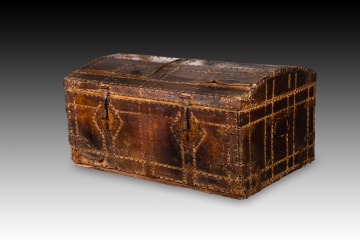
Trunk. Wood, leather, iron. Spanish School, around 1700. Wooden trunk with a curved lid and rectangular shape, covered with leather on the outside, with fittings, handles, studs and two closures at the front, which has a front and top opening. Inside it has a lower space accessible from the front divided in two by a vertical piece of wood; the lid and part of the chest have a textile covering. The back does not have leather. The nails with circular heads are arranged in geometric shapes. The handles have disc decorations. The fittings, also worked, follow models based on architectural designs, motifs also present in the lock shields on the front. Some of the metal elements still have traces of gilding. These types of trunks were known as “travel trunks” because they were normally used to store objects on journeys, hence the leather covering and the apparent lack of decoration on the outside. Having two locks was for greater security, since the two keys had to be used together to open it and these were usually entrusted to two different people. Compare this with the 17th century travel trunk from the Viceroyalty of Peru in the Museum of America (Madrid), which has decoration with animals and plant motifs (embossed leather). Or with the Chest of the Mayorazgo de la Cerda (17th century) in the National Museum of Decorative Arts (Madrid).
· Size: 85x129x65 cms.
ANTIQUES
FURNITURE
Ref.: ZF1245
-
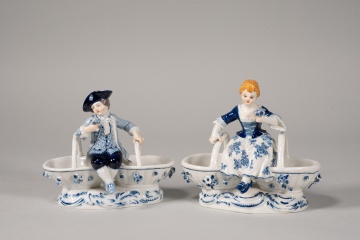
Pair of spice racks. Enameled porcelain. Meissen, Germany, possibly second half of the 19th century. Marks and inscriptions on bases. A pair of glazed porcelain spice racks, each with a base with raised waves reminiscent of the Rococo period, upon which are two baskets with handles and embossed flowers on the outside. A seated figure appears between the baskets: the young man wearing a hat, the girl holding a bouquet of flowers, and both also show 18th-century influences in their clothing. The predominance of white and blue is reminiscent of the first Chinese porcelains to arrive in Europe en masse, works that inspired numerous European factories. Inside the baskets, flowers can be seen reminiscent of the well-known Meissen onion pattern, but greatly simplified. The Meissen marks (two crossed swords, in blue) that appear on the bases of both figures are believed to have been used by the factory between 1815 and 1924. The figure of the male figure also features incised numbers (1320 and 73047) and the number 2521 in blue ink. The female figure also features inscribed numbers (136k, 73035) and a 1 in blue ink.
· Size: 14,5x8x12,5 cms
ANTIQUES
MISCELLANEUS;CERAMIC
Ref.: ZF1464
-
Photograph and signature. Vaslav Niyinsky (kyiv, 1890-London, 1950), 1914. Vaslav Niyinsky (transliterated Vátslav Fomich Nizhinski) was a Polish-born Russian ballet dancer and choreographer, considered one of the most gifted in history, notable above all for his meeting with Sergei Diaghilev, a member of the St. Petersburg elite and an important patron of the arts, who promoted Russian visual and musical art abroad, particularly in Paris. During the First World War, Nijinsky was placed under house arrest in Hungary for being a Russian citizen. Diaghilev managed to get Nijinsky out of the country thanks to the intervention of Alfonso XIII and his Oficina Pro Cautivos (Office for the Protection of Prisoners). The signature is accompanied by a photograph of the employees, which were used as business cards at the time (cabinet photograph), and is dated 1914.
· Size: 58x6,5x49 cms. int: 40,5x31 cms.
ANTIQUES
MISCELLANEUS;GRAPHIC WORK
Ref.: ZF1340B
-
Pair of forged iron fork locks. 17th century. Pair of forged iron fasteners of the so-called “fork” type due to their shape. This type of piece was used in furniture to secure tables, both dining tables and desks, and for this reason it is a very common piece of forged iron. The spirals and the balustrade parts date both to the Baroque period.
· Size: 93x30 cms.
ANTIQUES
MISCELLANEUS;OTHER OBJECTS
Ref.: Z5447
-
Office desk. Rosewood. Possibly Northern European, circa mid-20th century. A wooden desk or office table with four legs, a frame with two drawers, and a top with a ridge at the back that extends to the sides to prevent items from falling out. Stylistically, it's reminiscent of German and Scandinavian models from the mid-20th century or the 1960s and 1970s.
· Size: 140x80x75 cms.
ANTIQUES
FURNITURE
Ref.: ZF0323
-
Winged table with turned legs. Walnut wood. Spanish school, 18th century. A folding round table with two wings that can be folded down and supported by two legs joined together for each wing by means of lower jambs. When the table is folded, there is a drawer with a wooden knob on each side and two legs on each side, joined in a rectangle by means of a jamb. The legs and vertical elements of the piece of furniture have turned balustrade elements and discs, as is usual in the Spanish school since the Baroque.
· Size: 107x 37x76 cms / Abierta 107x103x76 cms.
ANTIQUES
FURNITURE
Ref.: ZF1173
-
Silver naveta. Spain, 17th century. A forged vessel with the base and lid finials obtained by mould casting. Shaped like a symmetrical boat, it stands on a low circular base with a disc-shaped base and a short shaft with a central lens. The body is decorated by chiselling, with oval cartouches flanked by braces and crowned by rhombuses and half-moons, located on the four axes and on a dotted shaded background that extends outlining the mouth. The lid has the same chiseled motif. At the stern end there is a finial in the form of an acanthus leaf, in relief, and at the bow end there is a handle in the form of a banded pillar. The bow lid is openable thanks to a central hinge. The piece has partial punch marks on the lid and body.
· Size: 18,5x9x8,5 cms.
ANTIQUES
MISCELLANEUS;SILVER
Ref.: ZF1253
-
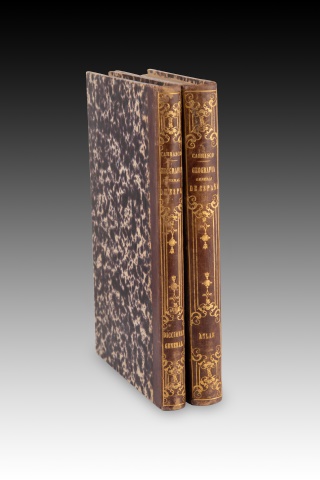
Two volumes: Geographical Atlas of Spain (…) and General Dictionary of all Peoples. Editors Gaspar y Roig. Spain, Madrid, 1864 and 1862. Two volumes framed in a similar way, with leather spines and gold elements. Here a reference to each work (lower area) and the name Carrasco (upper part) appear clearly. One of the volumes is the Geographical Atlas of Spain. Adjacent Islands and Spanish Overseas Possessions. It is indicated that it belongs to the “Collection of maps engraved in steel constructed by Don Martín Ferreiro”, and that it was published in Madrid by the Printing and Bookshop of Gaspar y Roig (the editors), in 1864. It presents a series of maps, engraved in steel (see the touches of color), constructed by Martín Ferreiro and Peralta (1830-1896) and engraved by R. Alabern (indicated under the images). The other volume is the General Geography of Spain. General dictionary of all peoples., belonging to the so-called Illustrated Library of Gaspar and Roig. Published in Madrid, by the Printing and Bookshop of Gaspar and Roig (editors), in 1862.
· Size: 18x5x27 cms.
ANTIQUES
MISCELLANEUS;OTHER OBJECTS
Ref.: ZF1298
-
“Ramón Aranaz”. Bust in bronze. Antonio Yerro Feltrer (Valencia, 1842-1911). Signed. Founder “V. Ríos”. Bust of Ramón Aranaz (Valencia 1831-Madrid 1898), businessman, banker and Valencian politician, dressed in a suit and with a ribbon across his chest. The sculptor, Antonio Yerro, studied at the Academy of Fine Arts of San Carlos in Valencia, and won various prizes at exhibitions such as the National Fine Arts Exhibition of 1884 and was awarded several decorations in recognition of his artistic merits.
· Size: 27x22x39 cms.
ANTIQUES
SCULPTURE
Ref.: Z3707
-
Vase. Glass. Following models by Émile Gallé (Nancy, 1846-1904). Vase made of glass, with white, brown and gold tones, following both in technique and decoration the well-known Art Nouveau works of Émille Gallé, an artist internationally recognized both for his aesthetics and for his technical advances with glass ("enamel", "cameo", etc.).
· Size: 15x15x28 cms.
ANTIQUES
MISCELLANEUS;CERAMIC
Ref.: Z5671
-
Talavera inkwell, 18th century. Glazed ceramic. Talavera ceramic inkwell, decorated with cobalt blue enamel on a white tin slip With restorations
· Size: 16x16x7 cms.
ANTIQUES
MISCELLANEUS;CERAMIC
Ref.: Z5695
-
Devotional pendant in gold and enamel, Mary Magdalene and Saint John the Baptist, 18th century. Possibly Mallorcan. One of the windows is broken. Oval pendant decorated around its edges with turned gold bows and small metallic pearls. One of its fronts shows Mary Magdalene, as a hermit, with a skull, a cross and a book; the other presents the image of Saint John the Baptist, accompanied by a cross and a lamb, alluding to the Gospel text. These types of pieces were highly valued by their owners as elements of devotion, and could also, at the same time, contain a relic inside.
· Size: 4.5x0,5x4 cms.
ANTIQUES
MISCELLANEUS;OTHER OBJECTS
Ref.: Z6451
-
Candlestick with chain. Silver. Francesc. P. Arquer, Barcelona, Spain, circa 1825. With hallmarks, engraving and ownership marks (AS). Silver candlestick in its colour with an openwork bowl on two levels and raised on two small legs (inside which there is a vase-shaped piece to hold the candle and a braided decoration towards the centre), and a flat handle (curved towards the end, area where the third leg is located), decorated with a series of simple openwork shapes and fine strings of small pearls on the edges of the handle and the bowl. The piece has some engraving marks, others of ownership under the bowl (AS) and others of hallmark. The latter link the piece with Barcelona silverwork, placing it in the workshop of Francesc Arquer, and in the 19th century. Weight: 183 grams.
· Size: 28,9,5x5,5 cms.
ANTIQUES
MISCELLANEUS;SILVER
Ref.: Z6733
-
Candlestick with chain and clips. Silver. F. Roca, Barcelona, around the first half of the 19th century. With hallmarks and engraving marks. Silver candlestick in its colour with an openwork bowl raised on two small legs (inside there is a vase-shaped piece to hold the candle) and a flat handle (curved towards the end, area where the third leg is located), decorated with two bands of pearls on the sides (a motif that also appears on the edge of the bowl) and from the end of which emerges a chain that ends in some tweezers (which are placed on a piece soldered to the bottom of the handle). The piece has two engraving marks and other hallmarks under the bowl. The latter place the work in Barcelona, by F. Roca, a silversmith active in the city during the second half of the 18th century and the beginning of the 19th century. Weight: 185 grams.
· Size: 23,5 x 8,5 x 7 cms.
ANTIQUES
MISCELLANEUS;SILVER
Ref.: Z6734
-
Base. Carved and polychrome wood. Spanish school, 17th century. Rectangular base, made of carved and polychrome wood in grey tones, which has been decorated with a series of mouldings and toruses, some smooth and others enhanced with a fine relief of plant elements and garlands with a clear classicist influence. The piece is finished off with a spike to secure the sculpture that is placed on it. Weight: 6.4 kg.
· Size: 37x25x44 cms , altura base 23 cms
ANTIQUES
SCULPTURE
Ref.: ZE346
-
Peace-bearer. Bronze. 16th century. Bronze peace-bearer with an S-shaped handle on the back made of the same material and a decoration in light relief on the front showing, beneath an architectural composition with a clear classicist influence (a semicircular arch with a scallop shell inside and scrolls outside, two pillars with vegetal decoration and a base with heraldry), the Virgin Mary with the Child, accompanied by two angels and placed on a pedestal on which a legend can be seen (AVEREGINA/CELOUM?, in allusion to the Marian antiphon Ave Regina Caelorum, typical of the time of Lent).
· Size: 6.5x3x11 cms
ANTIQUES
SCULPTURE
Ref.: ZF0866
-
Niche. Gilded and polychrome pine wood. Spain, 17th century. A niche made of carved and gilded pine wood, decorated with mouldings, a scallop shape and plant elements on the upper part, which shows a clear classicist influence, common in some Spanish Baroque schools of the 17th century. This type of piece usually formed part of an altarpiece, and was normally used to house sculptures.
· Size: 47x14x66 cms
ANTIQUES
SCULPTURE
Ref.: ZF0954
-
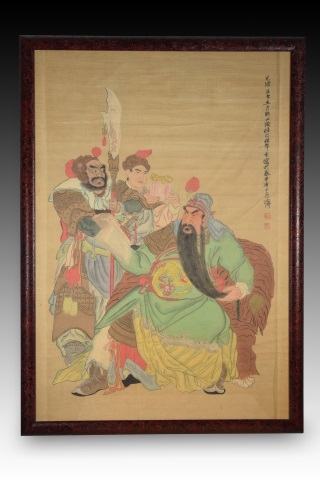
Guang Yu, Zhang Fei and Liu Bei. Watercolor. China, early 20th century. Framed painting showing three male figures, with a text on the right side. The one reading and sitting on a throne covered with tiger skin, stands out above all for his beard, but also for his rich clothing. The two characters are situated Standing, they also wear rich (although somewhat less) clothing, and one carries a halberd or spear while another carries an object in his hands. Guang Yu was a military general under Lui Bei during the late Eastern Han Dynasty and the Three Kingdoms Period of ancient China, and his life and achievements were so extolled and glorified that he was deified during the Sui Dynasty, emphasizing his exploits further in the Romance of the Three Kingdoms and becoming one of the main examples of loyalty and righteousness, receiving worship even today and receiving names such as "Emperor Guan" or "Lord Guan". Together with Zhang Fei shared a brotherly relationship with Lui Bei, and accompanied him on some of his early exploits. Weight: 9 kg.
· Size: 95,5x2x134 cms.
ANTIQUES
PAINTINGS
Ref.: ZF1075
-
Portrait of ancestors or family. Watercolor. China. Early 20th century. Painting with four richly dressed figures (two male and two female) seated on thrones or chairs dressed in rich cloths, located in an interior, attended by two servants (small in size, at the front of the work), and with an altar with several pieces of great value in the background of the composition. This type of work was very common in oriental art of certain schools, in line with the value placed on the ancestors of prominent families. Weight: 11.2 kg
· Size: 90x3,5x130 cms.
ANTIQUES
PAINTINGS
Ref.: ZF1076
-
Sold
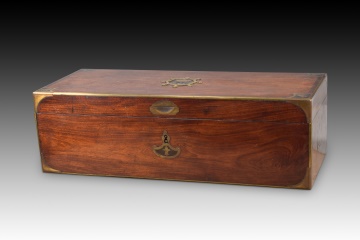
Box or casket with a royal monogram. Mahogany wood, metal. Spain, 19th century. It has slight damage. Rectangular box with a flat lid and a keyhole on the front decorated with metal appliqués on the corners, edges, handles, etc. A fleur-de-lis is featured beneath the keyhole. The lid features a central motif with fleur-de-lis and a crowned M, and alternating crowned castles and lions in the corners. This emblem (and the fact that it is accompanied by lions and castles, alluding to Castilian heraldry) is reminiscent of the royal monograms that, apparently, all members of the royal family had in the past to mark their belongings. In this case, it is possible that it refers to Maria Cristina of Bourbon-Two Sicilies (Palermo, 1806-Sainte-Adresse, 1878), wife of Ferdinand VII and regent during the minority of Isabella II. However, we must remember Maria Cristina of Habsburg-Lorraine or of Austria (1858-1929), wife of Alfonso XII. The emblem of Maria de las Mercedes de Orleans y Borbón (Madrid, 1860-1878), wife of Alfonso XII, usually appeared with two capital "Ms".
· Size: 78x31x24 cms.
ANTIQUES
MISCELLANEUS;OTHER OBJECTS
Ref.: ZF1170
-
18th century ponderal weight. Bronze. Incomplete bronze ponderal, with the container vessel and two of the smaller ones, all cold decorated with incised and stamped motifs, simple edges on the small vessels and more complex borders on the container vessel. Nested cup weights are a set of cup-shaped weights that fit precisely inside each other. A complete set is one that retains all its original cups. The largest, called the keeper, consists of an upper lid with a handle and a closure, and weighs exactly the same as the sum of all the others. The second in descending order weighs half as much as the keeper, and the same as the sum of the rest. This proportionality is maintained until the last weight, called the disk or last piece, which is usually solid and closes the set. This principle remained unchanged until the introduction of the decimal metric system.
· Size: 11x12x12 cms.
ANTIQUES
MISCELLANEUS;OTHER OBJECTS
Ref.: Z3034